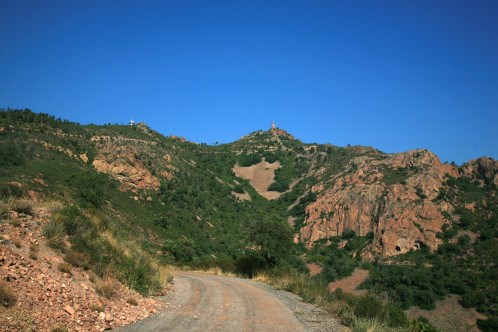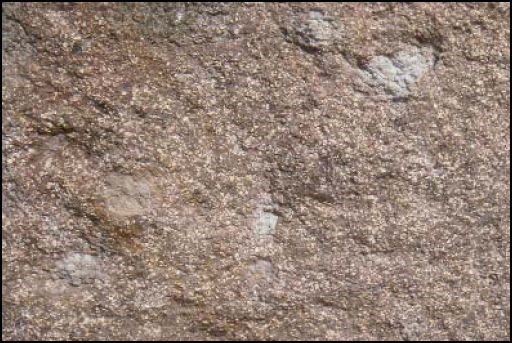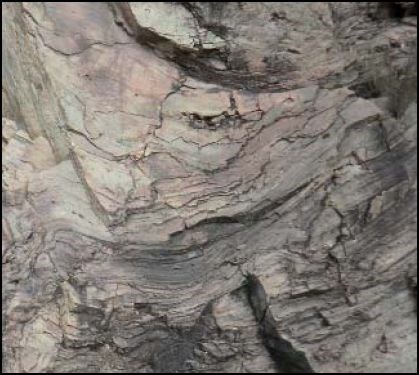Located between Cannes and Fréjus in the south of France, it is one of the most beautiful place of the French Riviera. The Mount Vinaigre is the highest peak (2,050ft) of this wild volcanic mountains. This volcanic range is one of the biggest european permian massif with full of peaks, ravines and gorges. Its fire-red colour form a terrific contrast with the blue of the mediterranean sea.

The permian period, (which ended in the largest mass extinction) is extended from about 299 to 252 million years ago.
The four more important types of volcanic rocks in the world are:
-
basalt
-
andesite
-
dacite
-
rhyolite
The Mount Vinaigre is made of rhyolite. This is an acid rock, this term refers to a high-silica-content (greater than 63% by weight). Now, this term « acid » is an archaic one and is replaced by the acronym felsic (combination of words feldspar and silica).
The rhyolite of the Mount Vinaigre is a red colored igneous rock with about 68 weight percent of silica. Its rocks has erupted at temperatures of 700 to 850°c.
Here, two types of rhyolite can be distinguished.These rhyolites are characterized by their flowing type during the volcanic eruption:

Pyroclastic Rhyolite

Flow Blanded Rhyolite
From the car park you can stroll up this mount by following GR 49 trail marked with a white over red blazes. And for a round trip, the road is a good way to go back to your car. This road is closed to car trafic.
You can log this EartCache by submitting answers to these tasks:
(Send me an e-mail with your answers)
-
The walls of this belvedere is made of rhyolite but which kind of rhyolite? And explain your answer.
-
Just before to go up the last stairs to the belvedere, on your left there is a huge rock of rhyolite (with four stripes painted on it). Describe me the orientation (vertical or horizontal) of this rhyolite and why? Wich color are the four stripes?
-
A small part of the Esterel has formed a small island that you can see in the south direction. What is the name of this island?
And if you want (It is optional), you can take a picture of you or your GPS unit.
Situé entre Cannes et Fréjus ,dans le sud de la France , il est l'un des plus bel endroit de la Côte d'Azur. Le Mont Vinaigre est le sommet le plus élevé (618m) de ces sauvages montagnes volcaniques. Cette chaîne volcanique est l'un des plus grand massif permien européenne avec plein de pics, de ravins et de gorges. Sa couleur rouge feu forme un contraste extraordinaire avec le bleu de la mer Méditerranée.
La période du Permien ( qui s'est terminée dans la plus grande extinction de masse ) est étalée entre 299 et 252 millions années.
Les quatre types les plus importants de roches volcaniques dans le monde sont:
- basalte
- andésite
- dacite
- rhyolite
Le Mont Vinaigre est fait de rhyolite . Il s'agit d'une roche acide, ce terme se réfère à un silice de teneur élevée ( supérieure à 63% en poids ) . Maintenant, ce terme « acide » est archaïque et remplacé par le sigle felsic ( combinaison de mots feldspath et silice).
La rhyolite du Mont Vinaigre est une roche ignée de couleur rouge avec environ 68 pour cent en poids de silice. Ses pierres ont éclaté à températures de 700 à 850 ° c .
Ici, deux types de rhyolite peuvent être dénombrées.Elles sont caractérisées par leur type d'écoulement lors de l'éruption volcanique.
-la première est appelée : rhyolite pyroclastiques avec dedans des ignimbrites (dépôts de coulées pyroclastiques ) et de tufs aérés et des agglomérats abondants . Cette rhyolite a été faite lors d'une coulée pyroclastique . Nous avons trouvé à l'intérieur une matrice vitreuse . Ces roches sont le résultat d'une éruption volcanique explosive. Une coulée pyroclastique est un courant en mouvement rapide des gaz chauds et de roches. Ce flux est également connu sous le nom de densité de courant pyroclastique .
- l'autre est appelée: rhyolite fluidale. L'apect est provoqué par le frottement du magma visqueux qui est en contact avec une interface de roche dure. Beaucoup de cristaux de quartz et de feldspath sont pris dans les marges du flux volcanique. Cette texture est commune dans la lave (forme horizontale) ou dans des dykes (forme verticale).
Du parking, vous pourrez vous promener jusqu'à ce mont en suivant le sentier GR 49 marqué d'un trait blanc au dessus d'un trait rouge. Et pour un aller-retour, la route est un bon moyen pour revenir à votre voiture. Cette route est fermée au trafic automobile.
Vous pouvez valider cette EartCache en soumettant vos réponses à ces questions:
(envoyez moi vos réponses par e-mail)
- Les murs de ce belvédère sont faits de rhyolite, mais quel type de rhyolite? Et merci d'expliquer votre réponse.
- Juste avant de monter les dernières marches au belvédère, sur votre gauche, il ya un énorme rocher de rhyolite (avec quatre bandes peintes). Décrivez-moi l'orientation (verticale ou horizontale) de cette rhyolite et pourquoi? Dites moi les couleurs des bandes peintes. (
- Une petite partie de l'Esterel a formé une petite île que vous pouvez voir dans la direction sud. Quel est le nom de cette île?